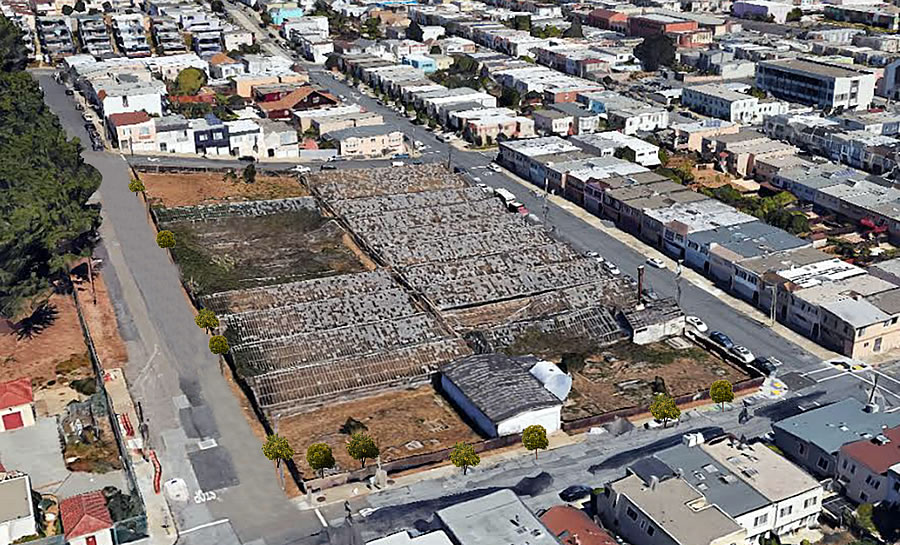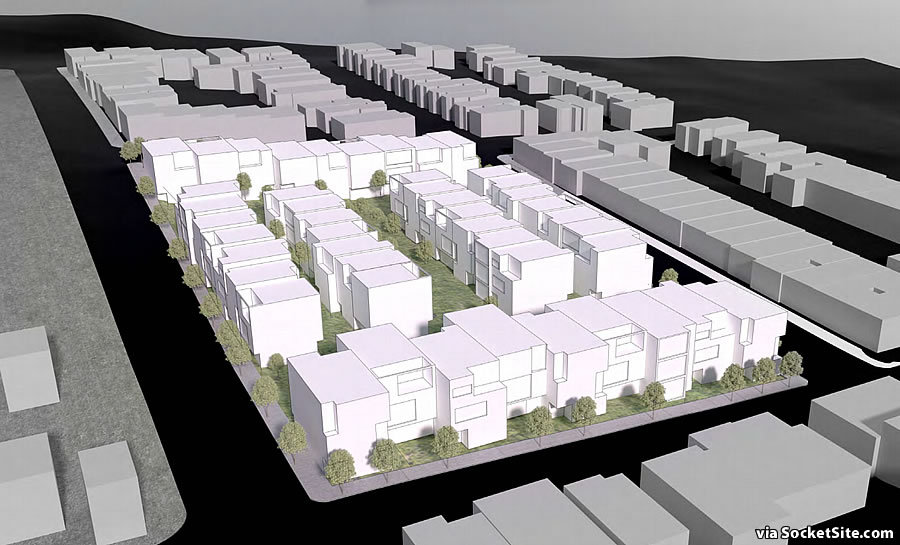Formerly owned by the Garibaldi family, the 2.2 acre Portola District block bounded by Woolsey, Hamilton, Wayland and Bowdoin streets, which is known as 770 Woolsey and is currently home to the decaying greenhouse remains of the family’s old University Mound Nursery (a.k.a The Rose Factory), was acquired by Group i for $7.5 million last year having hit the market in 2013 with a $12 million price tag.
Principally zoned for development of up to 34 new single-family homes, the parcel could potentially be developed with twice as many homes if a Conditional Use Permit for a Planned Unit Development (PUD) is approved for the site, as we first reported when the price tag for the site was reduced to $10 million in 2015. And while preliminary plans for an 86-unit development have been making the rounds, the formal application for a 63-unit development to rise up to 35 feet in height on the site have now formally been submitted to the City by Group i along with the Avant Group.
As drafted by Iwamoto Scott Architecture and newly massed below, the formally proposed development consists of 31 duplexes and a single-family home, with a total of 173 bedrooms and off-street parking for 64 cars.
And as envisioned, thirteen (13) of the proposed units would be offered at below market rates, with the “affordable” two-bedrooms priced from around $368K to $637K and the “affordable” three-bedrooms from $403K to $716K.
A grass roots campaign to co-purchase the parcel along with the PUC and turn the parcel into a community park, farm and flower garden was unsuccessful in raising the necessary funds or a purchase agreement. We’ll keep you posted and plugged-in.


More homes but still unequitable transit investment in the D10/D11/D7 neighborhoods vs downtown.
Amp it up Sfmta Caltrans and Caltrain Bart nd muni the 101 280 9 8 44 52 and T line need major changes
30 dwellings per acre isn’t bad but it’s not amazing either.
A community farm is a farking stupid idea that could be proposed only by those who understand neither farming nor cities.
The farm is idiotic as it sounds, but developing something where the roofs can be used as gardens is a great idea.
Putting the same amount of homes on one of the acres and a park on the other makes the most sense.
Why exactly is an urban farm such a “farking stupid idea?” There were farking farms all across the Portola for much of the twentieth century. There was one until pretty recently in the Bayview, above one of the Caltrain tunnels. The soil in this part of town is good; there are artesian wells; and this site has good sun and relatively little wind. It would have been really cool if they could have pulled this off….even if it was only part of the block. Now it will just be stack a shacks. Well, at least it is being designed by a good local firm.
“Cost” is the simple answer: does it make sense to try and put a farm on land that sells for $78/sf, when most farms are on land that sells for probably $78/acre? I guess you can argue it would be more of a community garden than a commercial enterprise, but whatever the merits of such an idea, it didn’t work out.
Generally I support your efforts to oppose the agoraphobes and preserve these small slivers of land, but I don’t think this is a good example of one: it has few trees, it’s not in anything approaching a natural state – tho admittedly the “natural state” of much of SF is a sand dune – in fact historically it’s really more industrial use than agricultural….covered in greenhouses, “factory” was an appropriate nickname.
Decent farmland in this state is more like $20000/acre, but I suppose you were exaggerating for effect. The thing is that a real farm is ludicrously productive and an urban farm is just a niche hobby. One of this size would feed a single adult if run well and of course it wouldn’t be run well. It’s just silly.
By contrast, this land is tremendously productive for urban humans. A person who is born and raised in this neighborhood has radically better later-life outcomes compared to almost any other place in America. Putting a bunch of plants in a place that could help a lot of people just tells those people that some rube’s hobby is more important than their opportunity.
Because we need homes more than we need additional vegetables and we’ve moved on from the 20th century. In the 17th century it was mostly sand dunes. We could also haul in a bunch of sand and . . . .
A community farm in an urban setting is well known to serve the same purposes as a community park – green space, understanding of nature, education for kids, etc. The garden spaces at Brooks Park is a good example of that. It’s not for actual food production efficiency. Now if you also think having green spaces/parks in a city is farking stupid, I can’t help you there. The only reason I do think the community farm is not a good idea HERE is because the location is already next to a huge green space (MacLaren Park).
Clearly this should be a 50-story residential tower…
just kidding about that. maybe not completely. this lot is large enough to put in a more significant structure, get at least 3 or 4 times the density of SFH and get the cost low enough maybe even teachers or firefighters might be able to afford it, rather than commuting many miles from out of town
While I totally agree we need more housing in the city, I also know of teachers and firefighters who could afford a small condo (2 incomes, say) in town but have decided they’d rather commute many miles from out of town to give their kids the backyard and space of a SFH. Some people just want the SFH experience and, esp with flexible work schedules, are willing to commute to have that. Building more condos only means maybe we can move people into those that are okay with the condo life, and possibly free up some SFH’s (w/multiple roommates, say) for families/pets/whatever reason people prefer SFH’s.
If they “prefer the SFH life”, they should probably move to Texas, Arizona, or the Midwest. Rather than imposing the environmental and other public and private costs of a drive til you qualify hour each way commuter lifestyle.
What, and lose the 5-10 years they may have already put towards pensions before they had kids and priorities changed? There are a lot of factors why people don’t just up and move to another state. Could be family is local, and childcare/sick parents often keep people in town. Eventually, living in the Bay Area might become so terrible people will want to move despite those factors, but we are not there yet.
I know, I know. But then, that suggests that they need to accept a more…European or urban lifestyle. Not every “family” needs the mythical single family house on the cul de sac. It is amazing how few people really USE those sacred, precious back yards in suburbia.
There are costs imposed on us by these lifestyle preferences. We as a society have accepted these costs, but they are nonetheless there…and growing.
I also disagree that the only definition of “terrible” is “I can’t afford a single family home”.
They don’t drive till they qualify. They own huge houses in El Dorado hills with a pool and ski boat in the driveway
These guys don’t ride Muni and drive a Prius
Good point. It is often a choice. A 3,500 square foot house in a gated community for their family of three, or a 1300 square foot house for basically the same price.
A lot of S.F. firemen/paramedics make 100k in OT alone!
Enough with this lumping then in with teachers. They are also much more likely than teachers to choose to live far from where they work for social reason as they are often conservative and dislike SF
Seems as though we could spare an acre in McLaren park for a community garden or urban farm and still build housing on this site…
It is not hard to see that the urban farm idea is just a tool to block more housing by the usual suspects. If the need for an urban farm was truly the main motivation here, the people pushing for it would petition SF Rec & Parks to carve out a space of McLaren park for urban farming. Obviously, nobody is pushing for that. Instead, the urban farm must be situated exactly on this block (ideally with ample parking for the locals.
Can they use the density bonus. This could easily be 6 floors over the entire acreage and house 600 instead of 60
Employing a density bonus would allow for the development of up to 54 units on the site. And while that’s 20 more units than for which the parcel is currently zoned, it’s 9 fewer than as now formally proposed with the PUD. And of course, the 63 units as proposed do average 2.75 bedrooms apiece.
I like the design. Lots of articulation. Maximizes the density while fitting in with the passing of the neighborhood.
UPDATE: The Refined Plans for That Decaying/Historic Portola Block